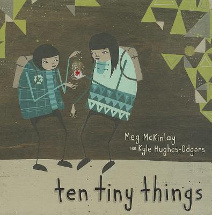Ten tiny things by Meg McKinlay

Ill. by Kyle Highes-Odgers. Fremantle Press, 2013. ISBN 9781921888946.
(Age: 3+) Recommended. Picture book. Walking. Environment. When the
machine breaks down the children must walk to school. Grumbling,
they miss their machine which is warm when they want warmth, cool
when they want it to be cooler, and gives them a smooth, swift ride
there and back again. But on walking to school, they notice things:
they see a bright shiny object which Zachary admits he has seen from
the machine, but only as a blur. Further on they see shells and
birds and trees, and when at school, they realise that they have
seen ten tiny things which they would not have seen when in the
machine and they have had the sun on their backs to keep warm. When
mum comes to school at the end of the day with the newly fixed
machine, the two prefer to walk home to see the secret things, the
hidden things, which they cannot see in the faster machine.
The illustrations with their few colours and abstract forms draw the
eyes to look more closely, seeing what the illustrator includes in
his sparse pictures. The spindly legs and arms of the children
contrast with their body shapes, and their clothing with its rich
array of patterns contrasts again with the triangular representation
of trees and buildings. Using wood panels on which to paint with
acrylic and wood stain, the impression is given of American
indigenous art, while the overall theme of walking not driving is
given a broad push in the whole book. It is not surprising to read
on the end paper, that both the author and illustrator are
proponents of walking, and disdain the use of machinery where
possible, although I'm sure a coffee machine is well used while
pondering a new book.
This book is intriguing and will beguile young eyes to look more
closely at its ideas are presented. This book will serve the teacher
well in introducing environmental issues such as the use of
machinery and its impact upon the environment in which we live.
Fran Knight